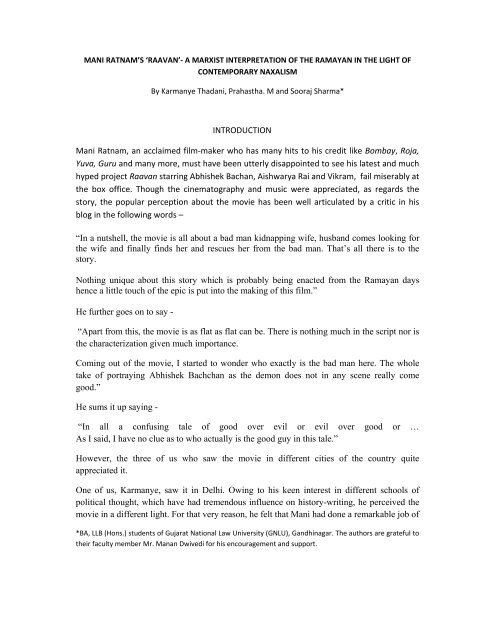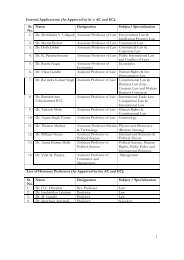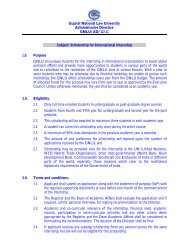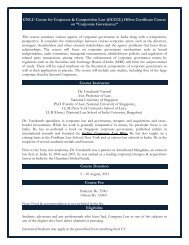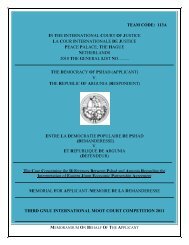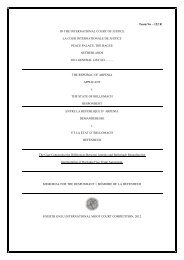INTRODUCTION Mani Ratnam, an acclaimed film-maker who has ...
INTRODUCTION Mani Ratnam, an acclaimed film-maker who has ...
INTRODUCTION Mani Ratnam, an acclaimed film-maker who has ...
You also want an ePaper? Increase the reach of your titles
YUMPU automatically turns print PDFs into web optimized ePapers that Google loves.
MANI RATNAM’S ‘RAAVAN’‐ A MARXIST INTERPRETATION OF THE RAMAYAN IN THE LIGHT OF<br />
CONTEMPORARY NAXALISM<br />
By Karm<strong>an</strong>ye Thad<strong>an</strong>i, Pra<strong>has</strong>tha. M <strong>an</strong>d Sooraj Sharma*<br />
<strong>INTRODUCTION</strong><br />
<strong>M<strong>an</strong>i</strong> <strong>Ratnam</strong>, <strong>an</strong> <strong>acclaimed</strong> <strong>film</strong>‐<strong>maker</strong> <strong>who</strong> <strong>has</strong> m<strong>an</strong>y hits to his credit like Bombay, Roja,<br />
Yuva, Guru <strong>an</strong>d m<strong>an</strong>y more, must have been utterly disappointed to see his latest <strong>an</strong>d much<br />
hyped project Raav<strong>an</strong> starring Abhishek Bach<strong>an</strong>, Aishwarya Rai <strong>an</strong>d Vikram, fail miserably at<br />
the box office. Though the cinematography <strong>an</strong>d music were appreciated, as regards the<br />
story, the popular perception about the movie <strong>has</strong> been well articulated by a critic in his<br />
blog in the following words –<br />
“In a nutshell, the movie is all about a bad m<strong>an</strong> kidnapping wife, husb<strong>an</strong>d comes looking for<br />
the wife <strong>an</strong>d finally finds her <strong>an</strong>d rescues her from the bad m<strong>an</strong>. That’s all there is to the<br />
story.<br />
Nothing unique about this story which is probably being enacted from the Ramay<strong>an</strong> days<br />
hence a little touch of the epic is put into the making of this <strong>film</strong>.”<br />
He further goes on to say -<br />
“Apart from this, the movie is as flat as flat c<strong>an</strong> be. There is nothing much in the script nor is<br />
the characterization given much import<strong>an</strong>ce.<br />
Coming out of the movie, I started to wonder <strong>who</strong> exactly is the bad m<strong>an</strong> here. The <strong>who</strong>le<br />
take of portraying Abhishek Bachch<strong>an</strong> as the demon does not in <strong>an</strong>y scene really come<br />
good.”<br />
He sums it up saying -<br />
“In all a confusing tale of good over evil or evil over good or …<br />
As I said, I have no clue as to <strong>who</strong> actually is the good guy in this tale.”<br />
However, the three of us <strong>who</strong> saw the movie in different cities of the country quite<br />
appreciated it.<br />
One of us, Karm<strong>an</strong>ye, saw it in Delhi. Owing to his keen interest in different schools of<br />
political thought, which have had tremendous influence on history-writing, he perceived the<br />
movie in a different light. For that very reason, he felt that <strong>M<strong>an</strong>i</strong> had done a remarkable job of<br />
*BA, LLB (Hons.) students of Gujarat National Law University (GNLU), G<strong>an</strong>dhinagar. The authors are grateful to<br />
their faculty member Mr. M<strong>an</strong><strong>an</strong> Dwivedi for his encouragement <strong>an</strong>d support.
putting across <strong>an</strong> interpretation of the <strong>an</strong>cient epic <strong>an</strong>d relating it to the contemporary class<br />
conflict m<strong>an</strong>ifesting itself in the form of the Naxal insurgency. He identifies himself as a<br />
Hindu but was not in the least offended by the movie portraying Ram in a somewhat negative<br />
light, the way members of radical org<strong>an</strong>izations like the Bajr<strong>an</strong>g Dal or Shri Ram Sene<br />
perhaps would (he, in <strong>an</strong>y case, hates these groups for their hate propag<strong>an</strong>da, communal<br />
rioting <strong>an</strong>d moral policing), because he believes, like m<strong>an</strong>y others do, that Hinduism as a<br />
religion (if at all it c<strong>an</strong> be called one) is flexible <strong>an</strong>d dynamic, <strong>an</strong>d the messages conveyed by<br />
the literature commonly referred to as Hindu mythological literature are of signific<strong>an</strong>ce rather<br />
th<strong>an</strong> the historicity of those events. Indeed, the Valmiki Ramay<strong>an</strong> in its true form <strong>has</strong> never<br />
been found <strong>an</strong>d multiple versions of it, all carrying interpolations, are available, which were<br />
written much later in the Gupta period in the early centuries of the Christi<strong>an</strong> era. Not only<br />
that, numerous literary adaptations of the epic in different vernacular l<strong>an</strong>guages have their<br />
own modifications of or additions to the story <strong>an</strong>d are also highly respected, like the one by<br />
Tulsidas in the Avadhi dialect of Hindi, Kamb<strong>an</strong> in Tamil <strong>an</strong>d Kritivyas in Bengali. While<br />
worshipping Ram in a temple, he bows before the Maryada Purshottam for the m<strong>an</strong>y good<br />
qualities attributed to him, caring little as to whether he was actually a great m<strong>an</strong> in history or<br />
even whether he existed at all. Even in the Pur<strong>an</strong>ic lore, there are contradictory versions of<br />
events in different Pur<strong>an</strong>as. Hinduism, unlike the Abrahamic religions, namely Judaism,<br />
Christi<strong>an</strong>ity <strong>an</strong>d Islam (which he indeed also genuinely respects), is not based on a single<br />
book to be accepted as infallibly true <strong>an</strong>d Hinduism <strong>has</strong> had m<strong>an</strong>y atheistic <strong>an</strong>d agnostic<br />
philosophies in it as well).<br />
Another one of us, Pra<strong>has</strong>tha, saw the movie in Hyderabad a few weeks before<br />
joining GNLU with his friend <strong>who</strong> had similar views about what the movie was trying to<br />
convey, which he shared with him (Pra<strong>has</strong>tha). Sooraj, <strong>who</strong> saw it in Pune, could also figure<br />
the concept of class divide <strong>an</strong>d male chauvinism the movie was trying to portray. The three of<br />
us, over dinner in the GNLU hostel mess, happened to discuss the movie <strong>an</strong>d were glad to see<br />
that we all shared a similar interpretation <strong>an</strong>d hence similar opinion of the movie (it is<br />
noteworthy that we hardly came across elaborate interpretations of the movie on the Internet<br />
also, though there were web pages referring to the movie having a Marxist touch).<br />
BACKGROUND<br />
Before we delve into the intricacies of what the movie is trying to convey, it may be useful to<br />
underst<strong>an</strong>d briefly the Marxist school of thought, what a Marxist interpretation of the<br />
Ramay<strong>an</strong> c<strong>an</strong> me<strong>an</strong> <strong>an</strong>d the contemporary issue of Naxalism.<br />
Marxism, to explain it in <strong>an</strong> oversimplified fashion, is a theory introduced by Karl Marx <strong>an</strong>d<br />
Frederick Engels, by virtue of which economics is the base of the social superstructure.<br />
Marxism diagnoses social problems as being a class conflict between the “haves” <strong>an</strong>d the<br />
“have-nots”. As per the Marxist discourse, the have-nots are subjected to exploitation by the<br />
capitalists, <strong>an</strong>d the State is also <strong>an</strong> institution that supports this class exploitation, leading the<br />
have-nots to org<strong>an</strong>ize <strong>an</strong> armed revolution to overthrow the existing order <strong>an</strong>d establish their<br />
dictatorship (known as a communist regime), eventually giving way to a classless, stateless<br />
society.
Marxism is a very strongly atheistic ideology, according to which God <strong>an</strong>d religion are<br />
creations of the privileged classes to exploit the underprivileged <strong>an</strong>d keep them under control<br />
(we are not Marxists ourselves <strong>an</strong>d not even atheists). Under the circumst<strong>an</strong>ces, it is<br />
underst<strong>an</strong>dable that Marxists <strong>an</strong>d those strongly influenced by Marxist ideas (even if not<br />
<strong>who</strong>lly subscribing to the ideology) will try to dissect the scriptures of different religions <strong>an</strong>d<br />
examine them using the yardstick of class conflict. In a certain sense, even women are<br />
regarded as a class economically dependent on men <strong>an</strong>d Marxists are generally feminists, at<br />
least in the moderate sense of the term. The Ramay<strong>an</strong>, a text revered by Hindus, <strong>has</strong> been no<br />
exception in terms of undergoing Marxist dissection.<br />
R<strong>an</strong>g<strong>an</strong>ayakamma, a Marxist writer, in her book ‘Ramay<strong>an</strong>a – The Poisonous Tree’ <strong>has</strong><br />
elaborated about the concerned theme. Even otherwise, we feel that no one c<strong>an</strong> deny m<strong>an</strong>y<br />
wonderful things in that epic which are relev<strong>an</strong>t for all times to come. The author <strong>has</strong> pointed<br />
out that the Ramay<strong>an</strong> “supports the civilized non-tribal communities against primitive tribal<br />
communities” <strong>an</strong>d “male chauvinism against women”.<br />
It is highly debatable as to whether the Ramay<strong>an</strong> <strong>has</strong> a historical core at all, unlike the other<br />
great Hindu epic, the Mahabharat, the historical core of which is widely accepted. However,<br />
assuming the Ramay<strong>an</strong> does have a historical core, the authenticity of Valmiki’s account is<br />
questionable. There is a proverb that history is often written from the victors’ perspective. It<br />
is well known that the Ary<strong>an</strong>s, <strong>who</strong> hailed from Central Asia (there is a huge controversy<br />
regarding this as well), invaded what is today India <strong>an</strong>d looked down upon the indigenous<br />
tribals, often enslaving them. They perceived themselves to be a superior race, with the term<br />
arya (Ary<strong>an</strong>) being a mark of respect <strong>an</strong>d das (a term basically me<strong>an</strong>t for indigenous tribals)<br />
came to me<strong>an</strong> ‘slave’. It is often contended that the so-called demons in the Ramay<strong>an</strong> were<br />
actually powerful indigenous tribals <strong>who</strong> resisted Ary<strong>an</strong> suzerainty (there are references to<br />
the demons obstructing Ary<strong>an</strong> religious rites <strong>an</strong>d rituals being conducted in the forests).<br />
People of this view claim that they were demonized merely because they w<strong>an</strong>ted to retain<br />
their tribal culture in their forest-villages, without accepting the so-called civilized lifestyle<br />
<strong>an</strong>d fought for their rights. The Vedas mention various acts of genocide of the tribals by the<br />
Ary<strong>an</strong>s, referring to the killing as dasyuhatya, though the same Vedas also have verses in<br />
which some Ary<strong>an</strong>s regret their wrongdoings <strong>an</strong>d there are verses talking of a “unity of<br />
hearts” between the Ary<strong>an</strong>s <strong>an</strong>d non-Ary<strong>an</strong>s as well.<br />
Likewise, in contemporary times too, tribals have been displaced from their homel<strong>an</strong>ds owing<br />
to development projects being undertaken by the government without being duly<br />
compensated <strong>an</strong>d their traditional rights of access to forests <strong>an</strong>d over forest produce were not<br />
respected in the name of environmental conservation, though the government <strong>an</strong>d not the<br />
tribals have been responsible for massive deforestation. Tribals have traditional knowledge of<br />
environmental conservation <strong>an</strong>d would never do <strong>an</strong>ything to destroy the forests, their lifebase.<br />
At times, tribals have been subjected to rather inhum<strong>an</strong> atrocities when they have<br />
attempted to resist forced displacement or tried to access the forests. The forest officers,<br />
including the forest guards, have often been very brutal with the tribals. Their indigenous<br />
culture is destroyed once they are compelled to integrate in the mainstream society. M<strong>an</strong>y<br />
non-tribals, particularly in urb<strong>an</strong>ized societies, often look upon the tribals as backward,
inferior people, <strong>who</strong>se rights c<strong>an</strong> be sacrificed. The Scheduled Tribes <strong>an</strong>d Other Traditional<br />
Forest-Dwellers (Recognition of Forest Rights) Act, also known as the Forest Rights Act, <strong>has</strong><br />
been passed to address the problems of the tribals, but it <strong>has</strong> not been implemented<br />
effectively yet.<br />
Marxist radicals have made the tribals to fight against the government using violent methods,<br />
<strong>an</strong>d this movement is called the Naxalite movement or Naxalism (Naxalism isn’t only a tribal<br />
movement, but we are dealing with the issue in a very limited sense in this context). They<br />
have resorted to kidnappings, extortions <strong>an</strong>d even attacks on innocent civili<strong>an</strong>s by bombing<br />
election booths <strong>an</strong>d derailing trains. The tribals may be crude <strong>an</strong>d unsophisticated in our eyes,<br />
<strong>an</strong>d taking up arms against the State <strong>an</strong>d challenging the democratic framework may well be<br />
incorrect (we believe it is highly incorrect, particularly the killing of innocent civili<strong>an</strong>s, <strong>an</strong>d<br />
we believe that the merits of democracy outweigh its demerits), but they are fed up with the<br />
so-called civil society that is snatching away their livelihood from them <strong>an</strong>d destroying their<br />
culture.<br />
While combating Naxalism, the police personnel have been very inhum<strong>an</strong> in their approach,<br />
inflicting atrocities against innocent tribals, killing them in fake encounters <strong>an</strong>d detaining<br />
them misusing <strong>an</strong>ti-terrorism statutes. The tribals in today’s Naxal areas are often in general<br />
stigmatized as terrorists the way, in the Vedic Age, perhaps the tribals were labelled as<br />
demons.<br />
DISECTING THE MOVIE<br />
Now, we shall examine the plot of the movie in some detail <strong>an</strong>d elucidate with examples how<br />
<strong>M<strong>an</strong>i</strong> <strong>Ratnam</strong> indeed intended to showcase a Marxist version of the Ramay<strong>an</strong> relating it to<br />
Naxalism. The art of interpretation, hermeneutics, <strong>has</strong> two methods of functioning – by<br />
recovery <strong>an</strong>d by suspicion. It is the latter that <strong>has</strong> been employed by <strong>M<strong>an</strong>i</strong> <strong>Ratnam</strong> while<br />
interpreting the movie here, where he is actually questioning the portrayal of good <strong>an</strong>d evil in<br />
the Ramay<strong>an</strong> being a method of showcasing Ary<strong>an</strong> superiority. <strong>M<strong>an</strong>i</strong> <strong>Ratnam</strong> having Marxist<br />
le<strong>an</strong>ings <strong>has</strong> perhaps amply demonstrated by the fact that his son wrote a book on Marxism.<br />
The <strong>film</strong> opens with shots showing Beera (Abhishek Bachch<strong>an</strong>), a tribal leader, <strong>who</strong> is the<br />
equivalent of Rav<strong>an</strong> from the Ramay<strong>an</strong> in the movie, jumping off a cliff into the water in a<br />
forest. Me<strong>an</strong>while, the police have some tribals in their custody <strong>who</strong> are being harassed,<br />
while Beera’s g<strong>an</strong>g is busy distracting the police, the way the demons in the Ramay<strong>an</strong> are<br />
always a source of nuis<strong>an</strong>ce to the Ary<strong>an</strong>s. Police vehicles are set ablaze <strong>an</strong>d even some<br />
police personnel in the forest are burnt alive. Ragini Sharma (Aishwarya Rai), the equivalent<br />
of Sita, on a boating trip, is abducted by Beera (we all know that Rav<strong>an</strong> abducted Sita in the<br />
Ramay<strong>an</strong>). Dev Pratap Sharma (Vikram), the equivalent of Ram, her husb<strong>an</strong>d <strong>an</strong>d a<br />
Superintendent of Police (SP), is informed.<br />
Dev <strong>an</strong>d his team enter the forests with the aid of S<strong>an</strong>jeev<strong>an</strong>i Kumar (Govinda), a forest<br />
guard (he <strong>has</strong> been one for the last 28 years), the equivalent of H<strong>an</strong>um<strong>an</strong>, <strong>who</strong> initially
prohibits Dev from entering the forest, the way H<strong>an</strong>um<strong>an</strong> initially had <strong>an</strong> altercation with<br />
Ram <strong>an</strong>d Lakshm<strong>an</strong> when they came to the forest zone. The name S<strong>an</strong>jeev<strong>an</strong>i Kumar (one<br />
may recall that H<strong>an</strong>um<strong>an</strong> got the S<strong>an</strong>jeev<strong>an</strong>i herb in the Ramay<strong>an</strong>), <strong>an</strong>d his monkey-like<br />
<strong>an</strong>tics, besides his referring to himself as a va<strong>an</strong>ar (monkey) metaphorically make it evident<br />
right in his first scene that he is the equivalent of H<strong>an</strong>um<strong>an</strong> in the movie. His being a forest<br />
guard is relev<strong>an</strong>t, because forest guards are a part of the State machinery, <strong>who</strong>, as mentioned<br />
earlier, have stopped tribals from accessing the forests, owing to the prevailing legal system,<br />
<strong>an</strong>d this denial of access by forest guards <strong>has</strong> been a major cause of Naxalism.<br />
A brief montage of sorts showcases the story of Beera. He is seen as a local hero, <strong>who</strong> runs a<br />
parallel government in the forest-village in which he executes justice in a very crude fashion<br />
with punishments like chopping off a h<strong>an</strong>d (indeed, the Naxalites do have such parallel<br />
governments in m<strong>an</strong>y districts across India), 32 years of age with numerous crimes to his<br />
credit, including attacks on police personnel <strong>an</strong>d punishments awarded by him to tribals.<br />
Likewise, even in the Vedic Age, the tribals had their own governments with their chiefs, but<br />
the Ary<strong>an</strong>s claimed sovereignty over them, using methods like the ashwamedh yagya. Even<br />
today, the tribals are often compelled to integrate in mainstream society with their traditional<br />
govern<strong>an</strong>ce patterns fading away, though the Declaration on the Rights of the Indigenous<br />
Peoples, to which India is a signatory, emp<strong>has</strong>izes protection of their culture <strong>an</strong>d their right of<br />
political self-determination. Beera <strong>has</strong> two brothers - M<strong>an</strong>gal (Ravi Kish<strong>an</strong>) <strong>an</strong>d Hari (Ajay<br />
Gehi). Though considered a criminal by the local police, Beera is respected <strong>an</strong>d feared at the<br />
same time by the tribals <strong>who</strong> despise the police. Dev, while referring to Beera, clearly states<br />
that he perceives him to be like Rav<strong>an</strong> <strong>an</strong>d says that Beera is, in a way, present at a number of<br />
places at the same time <strong>an</strong>d <strong>has</strong> ten faces (metaphorically speaking) <strong>an</strong>d he (Dev) resolves to<br />
kill him (Beera). This tribal region is called Lal Maatee (red soil) in the movie, <strong>an</strong>d the colour<br />
red is a symbol of Marxism because it signifies a bloody revolution. Beera, through a person<br />
he had tied up to a tree, conveyed to Dev that police personnel c<strong>an</strong> never find their way in the<br />
dense forests without some assist<strong>an</strong>ce, which is generally true <strong>an</strong>d something the Naxals take<br />
great adv<strong>an</strong>tage of.<br />
In a subsequent scene, Beera tries to shoot Ragini, but like a typical Ary<strong>an</strong> lady, she attempts<br />
suicide by jumping into the water to die <strong>an</strong> honourable death. Ragini deeply loves Dev <strong>an</strong>d is<br />
a courageous wom<strong>an</strong>, as <strong>has</strong> been shown time <strong>an</strong>d again in the movie, <strong>an</strong>d her fearlessness<br />
inspires awe for her in Beera’s mind <strong>an</strong>d he rescues her. She cries <strong>an</strong>d hurls abuses at Beera,<br />
<strong>an</strong>d he tells her that he prefers abuses to be hurled at him th<strong>an</strong> see a wom<strong>an</strong> cry. Indeed, the<br />
tribals have often had more respect for women in their cultures th<strong>an</strong> the Ary<strong>an</strong>s <strong>an</strong>d m<strong>an</strong>y<br />
Naxals, owing to their Marxist indoctrination, are gender-sensitized <strong>an</strong>d m<strong>an</strong>y women too are<br />
recruited in their cadres (though there actually have been at least some cases of their sexual<br />
exploitation by their male comrades). Indeed, in the Ramay<strong>an</strong>, Rav<strong>an</strong> never forced himself on<br />
Sita, though he asked her numerous times to accept him as her husb<strong>an</strong>d, <strong>an</strong>d even in the<br />
movie, Beera does not do injustice to Ragini despite getting attracted to her <strong>an</strong>d even asking<br />
her to forget her marriage with Dev <strong>an</strong>d accept him as her husb<strong>an</strong>d later in the movie. Despite<br />
being crude <strong>an</strong>d unsophisticated, Beera <strong>an</strong>d his brother M<strong>an</strong>gal treat Ragini with respect.<br />
Me<strong>an</strong>while, the tribals, on being questioned about Beera, describe him as a scholar (even<br />
Rav<strong>an</strong> was a great scholar as per the Ramay<strong>an</strong>) <strong>an</strong>d a poet, despite being <strong>an</strong> illiterate one,<br />
with a calm temperament, <strong>an</strong>d is a feared yet popular leader, though one wom<strong>an</strong> did criticize<br />
him, perhaps the only one among the tribals questioned.
In a subsequent scene, M<strong>an</strong>gal asked Beera why he did not kill Ragini, M<strong>an</strong>gal humourously<br />
stated that Beera had no reason to fear the law <strong>an</strong>d at the most, he may be detained in jail for<br />
a few years. The Naxal attitude towards the law c<strong>an</strong> indeed be summed up in the following<br />
statement of Charles Dickens – “Law is <strong>an</strong> ass”!<br />
Later, Beera gets a photograph of some of his fellow tribals clicked with Ragini in which they<br />
all were smeared to appear d<strong>an</strong>gerous <strong>an</strong>d Ragini too had a very fearful expression on her<br />
face (which was actually just because of a mild bop on her head by Beera’s brother M<strong>an</strong>gal<br />
before the photograph was clicked), which was sent to Dev along with a tape-recorded<br />
message of Beera, in which he articulates his views on the class conflict very clearly. He says<br />
– “SP Sahab, kaise ho? Ummeed hai aachche naheen honge... kyunki ham bhee achche<br />
naheen hain! Tumharee vajah se... tumre jaise bare logon kee vajah se... ham Beera <strong>an</strong>padh,<br />
gawar, gareeb... tumree jaisee oonch jaat naheen hai hamree... to ham tumre dusm<strong>an</strong>...<br />
photo dekhee hai... Pehch<strong>an</strong>a? Bahut tareeke se photo khichayee hai tumre liye... Isko<br />
sambhaalke kameej ke jeb mein rakhnaa... biwi vaapas naa aye to, kam se kam photo to<br />
rahegee paas mein... Ab samjhe dard ka hota hai? Namaste!” (How are you, Mr. SP? I hope<br />
you are not doing too well, because even we are not in a good position either! And that is<br />
because of you, because of well off <strong>an</strong>d powerful people like you! I, Beera, am uneducated<br />
<strong>an</strong>d poor <strong>an</strong>d I do not belong to a high caste like you; therefore, I am your enemy. Have you<br />
seen the photograph? Did you recognize your wife? We clicked the photograph after putting<br />
in some effort especially for you. Keep the photograph safely in your shirt pocket. If your<br />
wife doesn’t return, at least you c<strong>an</strong> keep the photograph. Now do you underst<strong>an</strong>d how it<br />
feels when you yearn for someone you love?). The reference to caste is import<strong>an</strong>t, because in<br />
the times of the Vedic Age <strong>an</strong>d even now, Hindus of so-called upper castes have regarded<br />
tribals to be of lower birth th<strong>an</strong> themselves (of course, a bl<strong>an</strong>ket generalization for all Hindus<br />
of supposedly upper castes would be incorrect at least in today’s context <strong>an</strong>d perhaps even for<br />
that period of history).<br />
In a subsequent scene, it <strong>has</strong> been shown that one policem<strong>an</strong> <strong>who</strong> was from the tribe was<br />
actually Beera’s informer. Indeed, the Naxals have informers in the police. The policem<strong>an</strong><br />
points out to Dev that senior officers like Dev seldom show up, but he <strong>has</strong> to live in the tribal<br />
village <strong>an</strong>d c<strong>an</strong>not afford to be hostile to Beera.<br />
Then, there is a song ‘Thok de Killi’ which <strong>has</strong> very me<strong>an</strong>ingful lyrics. The tribals complain<br />
that rich non-tribals tease them as backward, that tribals have been massacred in such large<br />
numbers that there isn’t even place to bury them <strong>an</strong>d that they will struggle to get a due share<br />
of the resources. They also indirectly say that the day is not far when India will be governed<br />
by a Communist government when they say “door naheen hai, chalega dilli” (Delhi is not<br />
far).<br />
Subsequently, Beera eventually tells Ragini the story of his sister's death; Dev had led <strong>an</strong><br />
encounter against Beera during the wedding of Beera’s sister Jamuni (the equivalent of<br />
Rav<strong>an</strong>’s sister Shoorpnakha from the Ramay<strong>an</strong>). Dev's shot grazed Beera in the neck. Beera<br />
escaped, but the police captured <strong>an</strong>d serially raped Jamuni, when she refused to reveal<br />
Beera's whereabouts. Beera returns home to find Jamuni distraught <strong>an</strong>d traumatized. The next<br />
day, she commits suicide by drowning in a nearby well. To avenge the injustice inflicted<br />
upon his sister, Beera abducted Ragini just the way Rav<strong>an</strong> abducted Sita to avenge the attack<br />
on his sister by Lakshm<strong>an</strong>. Even while taking Valmiki’s text into account without doubting<br />
the authenticity, questions c<strong>an</strong> indeed be raised as to why Ram <strong>an</strong>d Lakshm<strong>an</strong> kept making
her go from one brother to the other when she proposed to them for marriage, rather th<strong>an</strong><br />
respectfully telling her that neither of them was interested.<br />
Ragini, on hearing the tragic story about Jamuni, feels very sorry for Beera <strong>an</strong>d is nearly in<br />
tears. She goes to pray in front of a huge idol of a deity in the forest, <strong>an</strong>d says the following<br />
addressing the Lord – “main rona naheen chahti... mujhe gussa de do! Bas use kam mat karo!<br />
Mujhe in logon kee achchai, bholap<strong>an</strong> mat dikhao... main kamzor naheen hoon; mujhe<br />
kamzor mat b<strong>an</strong>ao!” (I don’t w<strong>an</strong>t to cry... Let me remain <strong>an</strong>gry! Don’t expose me to the<br />
innocence <strong>an</strong>d simplicity of these tribals... I am not <strong>an</strong> emotionally weak person, please don’t<br />
make me one!). This portrayal of tribals as basically simple <strong>an</strong>d innocent people <strong>who</strong> take up<br />
arms owing to frustration is a Marxist one. S<strong>an</strong>jeev<strong>an</strong>i Kumar somehow finds Ragini<br />
(H<strong>an</strong>um<strong>an</strong> finds Sita in the Ramay<strong>an</strong>), <strong>an</strong>d then just like H<strong>an</strong>um<strong>an</strong> was dragged to Rav<strong>an</strong>’s<br />
court, S<strong>an</strong>jeev<strong>an</strong>i is dragged to a tribal assembly presided over by Beera in which he warns<br />
Beera to peacefully let Ragini go, otherwise, Beera <strong>an</strong>d his men may have to pay for it with<br />
their lives, the way H<strong>an</strong>um<strong>an</strong> asks Rav<strong>an</strong> to let Sita go in the Ramay<strong>an</strong>. Beera tells<br />
S<strong>an</strong>jeev<strong>an</strong>i when he mentions the threat to his life, referring tpo hum<strong>an</strong> rights violations by<br />
the police –“hamaree maut tum logon ka khilwaad... tum sab ham logon to itnaa mare ho,<br />
itnaa mare ho, itnaa mare ho, ki khaag saalee motee ho gayee hai! Isliye haemin maut kee<br />
dhamkee mat do!” (for you people, our lives are playthings... you people have killed so m<strong>an</strong>y<br />
of our men that we are no longer afraid of death! So your threat is me<strong>an</strong>ingless for us!).<br />
Unhappy that his brother is ready for war, Hari (the equivalent of Vibheesh<strong>an</strong> in the<br />
Ramay<strong>an</strong>) convinces Beera to allow Hari to offer a truce to Dev. However, when Hari goes to<br />
meet Dev, he (Dev) shoots him (Hari) to death. This is a major aberration from the story of<br />
the Ramay<strong>an</strong>. We feel that if hermeneutics by suspicion were to be applied in this case, Dev<br />
could have been portrayed as giving Hari a huge bribe so as to help him overpower Beera.<br />
For in the Ramay<strong>an</strong>, Ram, as the prince of Koshal legally recognized Vibheesh<strong>an</strong> as the King<br />
of L<strong>an</strong>ka despite Rav<strong>an</strong> being the one <strong>who</strong> had actual administrative control. When Rav<strong>an</strong><br />
was killed, Ram had Vibheesh<strong>an</strong> coronated as the King of L<strong>an</strong>ka, making the de jure<br />
recognition by Ram a de facto one. A possible interpretation be that Vibheesh<strong>an</strong> joined<br />
Ram’s camp only to become the King of L<strong>an</strong>ka, but in that case, Valmiki’s version is sugarcoated<br />
because it is written with a bias in favour of Ram. And such <strong>an</strong> interpretation would<br />
make sense from a Marxist perspective where everything is understood in the light of a power<br />
struggle.<br />
Continuing our discussion of the plot of the movie, Beera <strong>an</strong>d M<strong>an</strong>gal are enraged after Hari<br />
was killed <strong>an</strong>d attack Dev's camp <strong>an</strong>d wipe it out. A final confrontation between Beera <strong>an</strong>d<br />
Dev takes place on a rickety bridge, where Beera prevents Dev from falling to his death. Dev<br />
later finds Ragini bound <strong>an</strong>d tied, with Beera leaving her. However, while riding a train back<br />
to their hometown, Dev accuses Ragini of infidelity <strong>an</strong>d informs her that it was Beera <strong>who</strong><br />
told him so, <strong>an</strong>d asks her to undergo a polygraph test to prove her claim to the contrary<br />
(similar to the agni pariksha or fire ordeal Sita underwent in the Ramay<strong>an</strong>), which shows a<br />
male chauvinistic approach. Furious, Ragini leaves Dev to meet Beera. When she does, she<br />
asks him what Beera had told Dev. Beera replies that he had said he protected Ragini for all<br />
the fourteen days <strong>an</strong>d not <strong>an</strong>ything else. They quickly realize Dev lied, hoping Ragini would<br />
lead him to his hideout. Dev appears with a police team <strong>an</strong>d confronts the duo. Ragini tries to<br />
save Beera, but he pushes her out of the line of fire. He is shot multiple times. Raagini's true<br />
feelings come to surface when she tries to save Beera with all her might. Content that Raagini<br />
<strong>has</strong> feelings for him, Beera falls off the cliff to his death with a smile.
In Retrospcet…………………..<br />
Irrespective of whether or not one is a Marxist or is inclined to accept the possibility of such a<br />
view about the Ramay<strong>an</strong>, <strong>M<strong>an</strong>i</strong> <strong>Ratnam</strong> displays his genius yet again by so creatively<br />
interpreting <strong>an</strong> epic in such <strong>an</strong> unconventional fashion <strong>an</strong>d improvising it in the contemporary<br />
context, relating it to the Naxalite movement. The story, if understood in that context,<br />
coupled with the awesome cinematography <strong>an</strong>d music of the <strong>film</strong>, c<strong>an</strong> be regarded as a<br />
classic of sorts in our opinion. However, the average person’s lack of underst<strong>an</strong>ding of what<br />
the movie was trying to convey prevented it from doing well at the box office.


